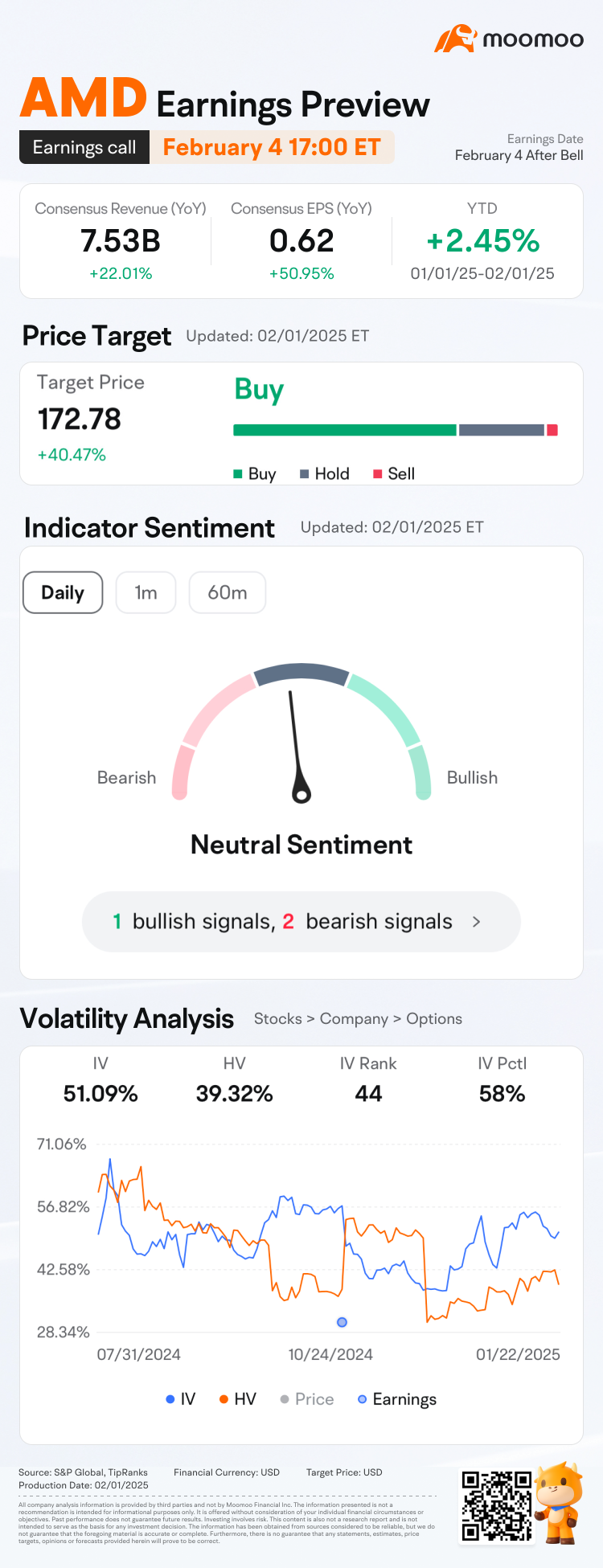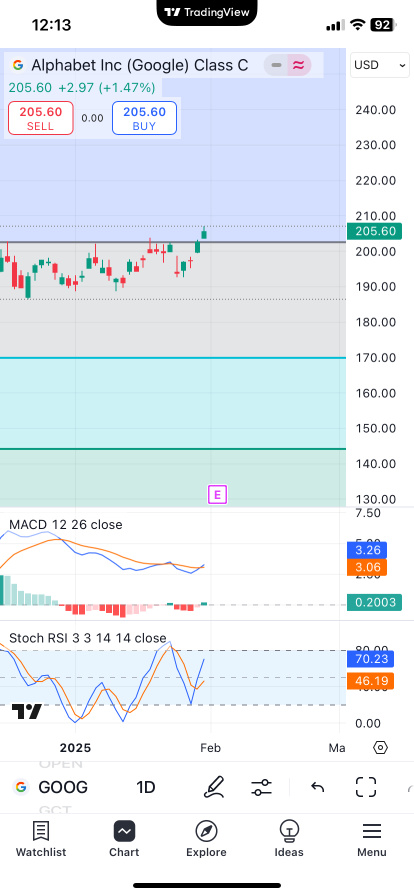Investment ThemesDetailed Quotes
SaaS
Watchlist
- 3614.176
- +25.659+0.72%
Close Jan 31 16:00 ET
3647.062High3607.954Low
3616.441Open3588.517Pre Close237.76MVolume17Rise44.27P/E (Static)56.34BTurnover2Flatline0.47%Turnover Ratio13.51TMarket Cap16Fall12.32TFloat Cap
Constituent Stocks: 35Top Rising: TEAM+14.92%
Hi mooers!
$Advanced Micro Devices (AMD.US)$ and $Alphabet-A (GOOGL.US)$ are both scheduled to release their Q4 earnings this week, with AMD's earnings on February 4 after bell and GOOGL's earnings on February 4 after bell.
The two companies are competing heavily over the AI chip market. As of February 1, $Advanced Micro Devices (AMD.US)$'s stocks price has seen an increase of 2.45% this year, and $Alphabet-A (GOOGL.US)$'s stock price has increas...
$Advanced Micro Devices (AMD.US)$ and $Alphabet-A (GOOGL.US)$ are both scheduled to release their Q4 earnings this week, with AMD's earnings on February 4 after bell and GOOGL's earnings on February 4 after bell.
The two companies are competing heavily over the AI chip market. As of February 1, $Advanced Micro Devices (AMD.US)$'s stocks price has seen an increase of 2.45% this year, and $Alphabet-A (GOOGL.US)$'s stock price has increas...



+3
1
1
Retail giants crushing earnings expectations amid strong consumer spending. E-commerce growth accelerating beyond market estimates. Technical indicators suggest continuation of upward momentum. Watch these leaders for potential breakout moves. retail trends
WMT SHOP AMZN
$Walmart (WMT.US)$ $Shopify (SHOP.US)$ $Amazon (AMZN.US)$
WMT SHOP AMZN
$Walmart (WMT.US)$ $Shopify (SHOP.US)$ $Amazon (AMZN.US)$
1
$Alibaba (BABA.US)$ $JD.com (JD.US)$ $PDD Holdings (PDD.US)$ $Tencent (TCEHY.US)$ $Baidu (BIDU.US)$ $BABA $BIDU $JD $PDD $TCEHY Sanctions and Tariffs on Chinese imports will no longer be effective like it was years ago. The China of today is a very different from yesteryears; much stronger technologically and militarily; all these achieved through innovations; diversification and expanding trades and building relations with many more countries in the world. US,...
4
3
$Alibaba (BABA.US)$ a healthy pullback in my opinion
$Microsoft (MSFT.US)$ Trump must stop his fucking tariffs shit so that market can stablize.. idiot guy to be honest
2
$Microsoft (MSFT.US)$ shit investment.. what's wrong with this counter man
$Alibaba (BABA.US)$ We might see it drop back to 90-95 on monday for BABA (US).
1
$Datadog (DDOG.US)$ got in yesterday. added today. we cashing in or is this thing gonna plum.et and take me out? what you thoughts fam?

1
No comment yet



Lucas Cheah : 1. $Advanced Micro Devices (AMD.US)$
Key Revenue Drivers
a) AI and Data Center Growth
• AMD’s Instinct MI300X GPU, a direct competitor to Nvidia’s H100 AI chip, has seen strong early adoption.
• For example, Microsoft and Meta have expressed interest in using AMD’s AI chips in their cloud and AI platforms.
• Impact: AI-driven demand could help AMD gain market share in the high-performance computing segment, contributing to double-digit revenue growth in data center sales.
b) Data Center & Cloud Computing
• AMD’s EPYC server processors continue to gain traction among cloud service providers like Amazon AWS, Google Cloud, and Microsoft Azure.
• For example, the latest EPYC Genoa and Bergamo processors offer improved efficiency, positioning AMD as a preferred choice over Intel’s Xeon chips.
• Impact: The cloud computing boom fuels continued revenue expansion.
c) Gaming and Consumer GPUs
• While demand for gaming GPUs softened in 2023, the launch of RDNA 3 GPUs and partnerships with Sony (PlayStation) and Microsoft (Xbox) provide steady revenue streams.
• For example, AMD supplies chips for gaming consoles, with demand expected to increase as the console cycle matures.
d) Embedded and Automotive Chips
• AMD’s Xilinx acquisition has expanded its presence in embedded computing and automotive AI.
• For example, Automotive AI partnerships could help AMD tap into the rising demand for autonomous driving chips.
Challenges & Risks
• Nvidia’s Dominance: Nvidia still leads in AI chips, and AMD must prove its MI300X GPUs can compete effectively.
• Macroeconomic Headwinds: A slowdown in PC and gaming chip demand could weigh on overall earnings.
• Manufacturing Dependence: AMD relies on TSMC for chip production, posing potential supply chain risks.
Outlook
AMD’s AI and data center businesses position it for strong growth, with AI adoption serving as the biggest catalyst for earnings expansion. While competition from Nvidia and Intel remains a challenge, AMD’s advancements in AI and cloud computing should help it deliver solid long-term growth.
2. $Alphabet-A (GOOGL.US)$
Key Revenue Drivers
a) Digital Advertising Dominance
• Alphabet generates the majority of its revenue from digital advertising via Google Search, YouTube Ads, and Display Network.
• For example, In Q3 2024, advertising revenue grew 11% YoY, driven by YouTube Shorts monetization and AI-powered ad targeting.
• Impact: The rise in digital ad spending, especially in e-commerce and video content, benefits Alphabet’s revenue stream.
b) YouTube Growth
• YouTube continues to grow as a leading video platform, competing with TikTok and Netflix.
• For example, YouTube Shorts (short-form videos) has over 2 billion monthly users, and Alphabet is improving its ad monetization model.
• Impact: Increased engagement from YouTube Premium subscribers and ad revenue strengthens Alphabet’s long-term earnings potential.
c) Google Cloud Expansion
• Google Cloud is Alphabet’s fastest-growing segment, competing with AWS and Microsoft Azure.
• For example, Q3 2024 saw 23% YoY growth in Google Cloud revenue, with enterprise AI adoption driving demand.
• Impact: AI-powered tools, like Vertex AI and Duet AI, are attracting enterprise customers, boosting long-term cloud revenues.
d) AI and Generative Search
• Google is integrating AI into Search, Gmail, and Docs, offering AI-powered enhancements.
• For example, Bard (Google’s AI assistant) is competing with OpenAI’s ChatGPT, showcasing Alphabet’s AI ambitions.
• Impact: AI-driven search features may boost ad revenues but could also impact cost-per-click (CPC) rates.
Challenges & Risks
• Regulatory Scrutiny: Alphabet faces multiple antitrust lawsuits in the U.S. and EU, potentially leading to fines or business model changes.
• AI’s Impact on Search Revenue: As AI-powered search reduces traditional ad clicks, it could disrupt Alphabet’s core business model.
• Cloud Competition: Google Cloud still lags behind AWS and Microsoft Azure, requiring aggressive expansion to gain market share.
Outlook
Alphabet’s AI and cloud investments position it well for long-term revenue growth. While regulatory risks and AI search changes pose challenges, strong digital ad performance and YouTube engagement provide stable revenue streams. The shift toward AI-powered enterprise solutions also strengthens Alphabet’s financial outlook.
In conclusion, both companies are set to benefit from AI adoption, with AMD excelling in hardware (AI chips) and Alphabet leading in AI software & digital ads. While AMD has higher upside potential, Alphabet’s diversified business model provides greater stability and cash flow.